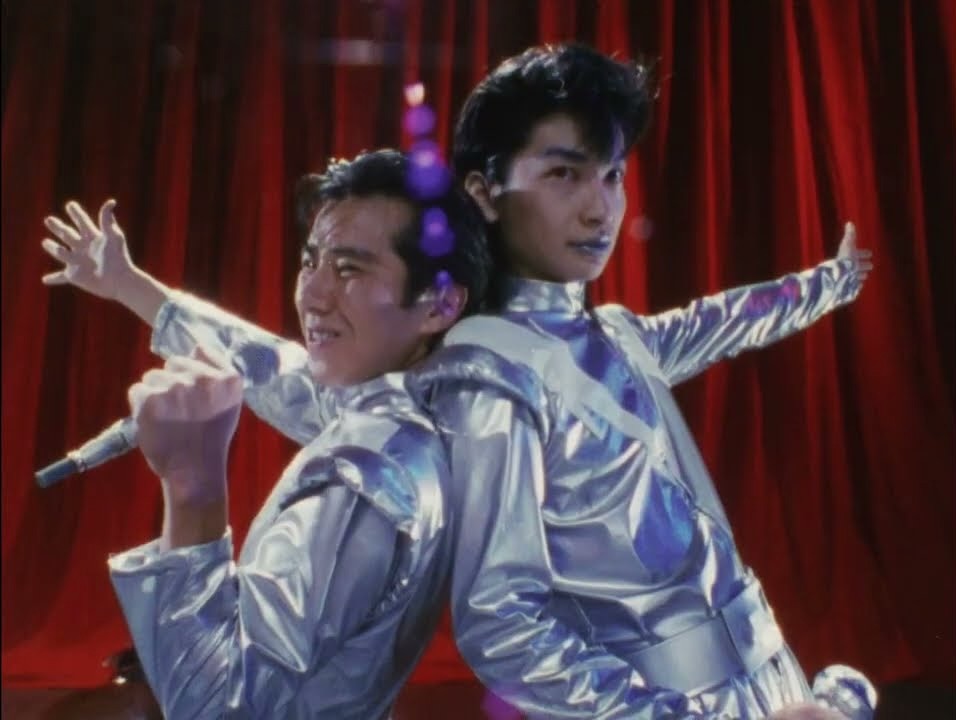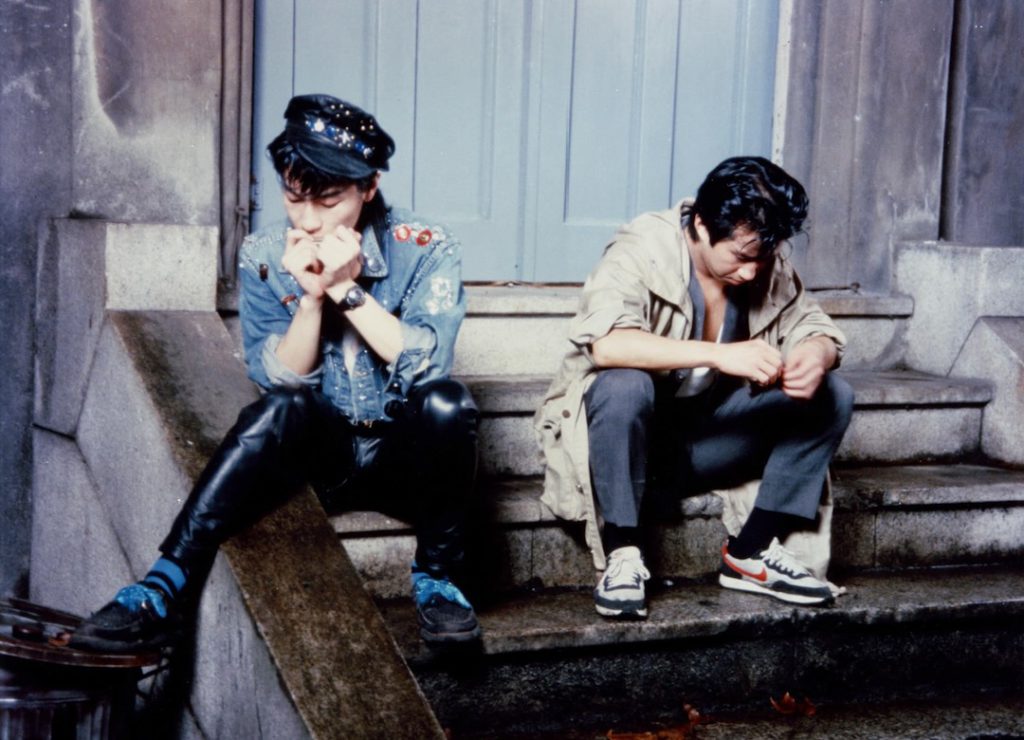
It’s Tokyo, 1985 and the vibe inside the nightclub is Cabaret, were that movie directed by David Lynch. The scene is shot in grainy black-and-white and filled with characters who look as if they are caught between the past, the present and a fever dream. At this moment, which is just seconds into The Legend of the Stardust Brothers, nothing could be too weird for you. Well, nothing, perhaps, except the appearance of the Stardust Brothers themselves.
Kan and Shingo, the washed-up pop stars at the center of the film, bolt onstage and on screen in full color, their silver jumpsuits shining, their tale of woe set to a glam rock beat. Kan tries to keep it together as Shingo gorges himself on food and drink. They are a brilliant mess, but the crowd is thoroughly unimpressed.
The Legend of the Stardust Brothers is a roller coaster ride through pop stardom that was nearly forgotten after its mid-1980s release. In recent years, though, the Japanese film was restored, screened at various film festivals and has gained a new life as a rediscovered cult classic. Now, you can find it streaming (I saw it on Tubi) or, maybe, catch a revival screening. Either way, you should see The Legend of the Stardust Brothers if you haven’t already because the story is likely more relevant now than it was nearly 40 years ago.
When the film opens, Kan and Shingo are two years and galaxies away from their brush with pop stardom. Soon, we flash back to a fateful battle of the bands where Kan leads popular punks London Boots and Shingo fronts a second-rate Wham! called Super Cars. They are polar opposites who are both summoned to a massive corporate building where a mysterious executive promises them fame and fortunate should they perform together as The Stardust Brothers. And he delivers! It only takes one montage for Kan and Shingo to become the next big thing.
Phantom of the Paradise, Brian De Palma’s 1974 musical, is the stated influence for The Legend of the Stardust Brothers, according to an interview with director Makoto Tezuka. The movie began as a collection of songs written by the singer Haruo Chikada, who later joined forces with Tezuka (also known as Makoto Tezka), then an up-and-coming filmmaker, to write the script. Tezuka, the son of manga icon Osamu Tezuka (Astro-Boy, Kimba the White Lion), directed the film with a visual style that blends music video, comic book and animation references.

While you can hear and see bits of the Phantom of the Paradise influence in The Legend of the Stardust Brothers, the film’s real predecessor is Head. In 1968, The Monkees released a feature-length swan song that directly commented on their manufactured success and the struggle between making art and making hits. The movie, which was co-written by Jack Nicholson, bombed and it wasn’t until years later that it was reassessed and rebranded as a cult classic.
Like Head, The Legend of the Stardust Brothers uses a series of distinct and extremely stylized musical sequences— each one of which could function as a video— to comment on the fame machine. (And, after watching a marathon of The Monkees over the weekend, I should also note that a lot of the visual gags in The Legend of the Stardust Brothers are similar to those used in the 1960s TV show.)
Unlike Head, The Legend of the Stardust Brothers has a well-defined plot. Kan and Shingo become stars, taking their fanclub president, Marimo, along for the ride. But, fame, they learn, is fleeting. Shingo’s behavior becomes more unhinged and the corporate powers that be tire of the duo’s attitude. Meanwhile, Marimo’s own career takes off and another hot male pop singer is poised to replace Kan and Shingo at the top.
There are good amount of music connections in the film. Kan and Shingo are played by Kan Takagi and Shingo Kubota, both of whom have released music over the years. Their manager, Atomic Minami, is played by Kiyohiko Ozaki, who was a well-known singer at the time of the movie (also, he was in House). Kyoko Togawa, who played Marimo, was both an actor and singer. Issay, who was Kaoru in the film, fronted the band Der Zibet.
I love how The Legend of the Stardust Brothers appears to riff on so many different music and fashion movements that were happening in the early 1980s. My personal favorite look is Kaoru’s goth creep style. He starts off looking like a cross between David Sylvian and Peter Murphy. As his persona grows increasingly diabolical, his makeup becomes more corpse-like and, when he chases Marimo through a hotel, the wide sleeves of his top flap like bat wings.
As the Stardust Brothers reach a pivotal point in their journey, shit gets really weird. In fact, it’s so bizarre that, by the final scene, you’ll be asking yourself what was real and what wasn’t even though you know that it’s all fiction. It’s literary-definition absurdity that points to the futility of trying to capture and hang onto something as ephemeral as fame. That’s particularly relevant now that we live in a timeline where one could become both famous and forgotten in a matter of weeks.
Liz O. is an L.A.-based writer and DJ. Read her recently published work and check out her upcoming gigs.
Keep Reading:
PHANTOM OF THE PARADISE IS THE ’70S ROCK MUSICAL YOU NEED TO SEE
A DER FAN SCREENING REMINDED ME OF THE IMPORTANCE OF GOING TO THE MOVIES
“ENERGY: A DOCUMENTARY ABOUT DAMO SUZUKI” PREMIERED IN L.A. AT PHILOSOPHICAL RESEARCH SOCIETY
